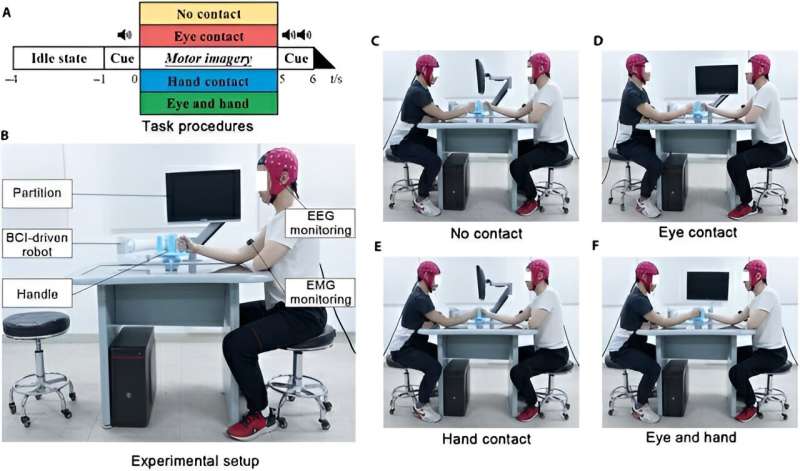This article has been reviewed according to Science X's editorial process and policies. Editors have highlighted the following attributes while ensuring the content's credibility:
fact-checked
peer-reviewed publication
proofread
Brain-to-brain technology boosts brain-computer interface performance, study demonstrates

A study from Tsinghua University in collaboration with Imperial College London has unveiled a novel technique that significantly enhances brain-computer interface (BCI) systems by integrating brain-to-brain interactions among users.
This innovative approach, detailed in a study, titled "Enhancing Brain–Computer Interface Performance by Incorporating Brain-to-Brain Coupling," in the journal Cyborg and Bionic Systems, demonstrates the potential for improved BCI performance in applications such as rehabilitation and multitasking devices.
The research, led by Dr. Tianyu Jia and a team of interdisciplinary scientists, explored the effects of social interactions, such as eye and hand contact, on BCI performance during motor imagery tasks—mental simulations of movement without physical execution. The study involved groups of friends and strangers to determine the influence of familiar social connections on neural synchronization and BCI efficiency.
The presence of a friend and physical interactions like eye and hand contact significantly improved BCI decoding accuracy by fostering stronger brain-to-brain neural synchronization. Participants who engaged in direct eye contact and physical touch with a familiar partner demonstrated greater cortical activation and connectivity, suggesting that social interaction can significantly enhance the effectiveness of BCIs.
Remarkably, these positive effects were predominantly observed among friends but not strangers, indicating the importance of pre-existing social bonds in maximizing BCI performance.
The study's results are promising for the future of BCI applications, particularly in fields requiring enhanced coordination between users, such as cooperative tasks and complex rehabilitation scenarios.
"Our findings suggest that incorporating interpersonal social interaction into BCI systems could revolutionize how these systems are used, making them more effective and responsive," said Dr. Jia.
For individuals with motor disabilities or those in rehabilitation, this research offers a new pathway to more effective treatments. BCI systems equipped with brain-to-brain coupling technology could potentially enhance recovery rates by leveraging natural human connectivity.
The success of this research opens avenues for further exploration into how social interactions influence other forms of technological interaction and cognitive performance. The team plans to extend their research to include diverse participant groups and clinical settings to better understand the broad applicability of their findings.
This study not only paves the way for enhancing existing BCI technologies but also underscores the profound impact of human connection on technological advancements. As BCIs continue to evolve, incorporating elements of human interaction could be crucial in designing more intuitive and effective systems.
More information: Tianyu Jia et al, Enhancing Brain–Computer Interface Performance by Incorporating Brain-to-Brain Coupling, Cyborg and Bionic Systems (2024). DOI: 10.34133/cbsystems.0116


















